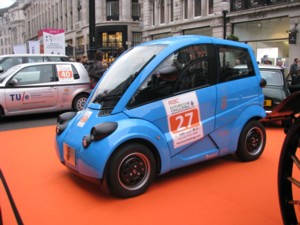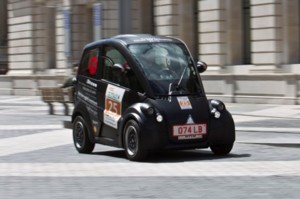We are developing the social individualist meta-context for the future. From the very serious to the extremely frivolous... lets see what is on the mind of the Samizdata people.
Samizdata, derived from Samizdat /n. - a system of clandestine publication of banned literature in the USSR [Russ.,= self-publishing house]
|
Earlier this year, I bought myself an FZ150. But now there’s an FZ200.
And the torture begins:
While in 2002 the 12x FZ10 had a maximum aperture of F2.8 across its entire zoom range, the 24x FZ150 in 2011 only offers this setting at its wider zoom positions. At the long end of the lens the maximum aperture is reduced to F5.2 which, in combination with the limited high-ISO capabilities of the small sensors typically used in superzooms, makes shooting at long focal lengths a difficult task in anything less than perfect light.
Now they tell me.
However, with Lumix DMC-FZ200, Panasonic has executed a veritable engineering coup by creating the first Lumix superzoom since 2004’s FZ20 to come with a F2.8 maximum aperture across the entire zoom range. And, unlike the 12x, 36-432mmm equivalent range of the FZ20, the FZ200 maintains F2.8 on a 24x, 25-600mm equivalent lens.
In combination with the newly-developed 12MP MOS sensor, this makes the FZ200, at least on paper, by far the best choice in the superzoom segment for low light shooting. That large aperture allows it to offer faster shutter speeds at the same ISO settings as its peers, or use lower sensitivities at the same shutter speeds as the competition.
Is this why some people hate progress?
The thing is, my FZ150 is the best camera I’ve ever owned.
And now there is a better one.
It is said, probably apocryphally, that in rejecting an appeal for the great French chemist Antoine Lavoisier to be spared the guillotine, the revolutionary judge said, “The Republic has no need of scientists”.
The great Pakistani physicist Abdus Salam, the first Muslim to win a Nobel prize for science, has been written out of Pakistani history for being the wrong sort of Muslim, writes Rob Crilly in the Telegraph. Among the saddest aspects of this story is that when reading this I could not wholeheartedly join in with Mr Crilly’s wish that Professor Salam’s name should again be honoured in his homeland. While public and elite opinion in Pakistan remains such that it does not wish to claim a great nuclear physicist – and one of the architects of Pakistan’s nuclear weapons programme – as its own, better for the world that Pakistan gets its wish.
Aside from doing grumpy postings like this one about them here, I am pretty much ignoring the Olympics. But today, while waiting for a BBC Radio 3 piano recital, I heard the BBC Radio 3 version of the news. And one of the big stories was that Lord Moynihan (he is some kind of British Olympic big cheese) was defending a gold medal winning Chinese swimmer against accusations of having been drugged. The margin of her victory in a swimming race was, according to a defeated American coach (so said Radio 3), “troubling”.
And there you have what is surely the fundamental problem of the Olympics.
I loath the Olympics for all sorts of reasons. The invading army of officious and corrupt imperialists telling me and my fellow Londoners how to run our own city, the costs that will be spread over lifetimes (including to those who have even less interest in the games than I do), the cock-ups caused by corruption, and by it being organised by a different bunch of organisers each time, the shameless statist propaganda in the opening ceremony (the entirety of which I have recording (sensing political rucki) but I have yet to watch the damn things and probably never will), etc. etc. etc.
But this drugs accusation, whether in this particular case true or baseless, gets to the heart of the problem with the Olympics.
I, and millions of others, just do not trust Olympic athletic victories any more. The wider the margin of them, the more we all distrust them.
After all, science and technology have progressed at a dizzying rate in recent decades, in all other areas where it has profited anybody to make such progress. Why not in athlete doping, in ways that doping detection cannot detect?
In Formula 1 car racing, everyone who pays attention knows that being and having the best driver is only half of the battle, if that. F1 is a struggle between engineers and designers, not just drivers. If your engineers fall behind, having the two best drivers on the planet driving your loser cars won’t win you the championship. Which is fine, because all of this is right out there in the open. No secret is made of any of this. One of the purposes of Formula 1 is to enable car makers to boast about their enthusiasm and excellence at technology, and maybe F1 even encourages regular car-making technology to get better.
In athletics, however, the collision between the idea of individuals racing, or throwing or jumping or whatever it is, and individuals being treated more like racing cars by teams of medical experts, is not nearly so happy. In fact it pretty much destroys the entire purpose of the exercise. I mean, what the hell is the point of winning a gold medal, or for that matter winning a bronze or coming seventh, if every second person you subsequently meet (even if too polite to say so to your face) reckons you probably cheated?
The problem is that whereas last year’s F1 cars are just scrap metal, or perhaps revered but still inanimate museum pieces, Olympic athletes have to spend several more decades actually living inside the bodies that were once mucked about with by Olympic doctors, so you probably can’t just allow the doctors to let rip, with any kind of biotechnology they can devise. Remember all those miserable ex-Soviet swimmers and gymnasts. But if you don’t allow this, or if you allow some biotechnology but not other kinds, you have to find some convincing way of policing it all. As of now, they are nowhere near to doing that convincingly.
And one thing’s for sure. None of these problems are going in any way to diminish, in the decades to come.
At present, my sport of choice, cricket, has no such doping problems, or if so they keep them very firmly under wraps. Not long ago, as I wrote about here, South Africa beat England at cricket. England didn’t just lose, they were humiliated, at home, in what everyone expected to be a very closely fought game. Yet nobody in cricket believes that this extraordinary South African triumph was caused by anything more complicated than the South African team playing much, much better than the England team did. Nobody called this result “troubling”, in the way that American coach meant it. Nobody is now suggesting that the South African team had been using illegal substances. They just batted far better and bowled far better, because … well, because they just did.
Cricket certainly has its cheating problems, but they are to do with people cheating by not trying hard enough, not by off-the-field medical wizards trying too hard.
“Russ in Texas” (actual name: Russ Mitchell) commented most interestingly on this posting here about 3D printing, the point being that he had, or soon would have, personal experience of actually doing this stuff. I urged him to write about any such experience, and here (with apologies to him for the delay in doing this posting) is the email he recently sent:
Here’s my experience:
3d Printing is mature and ready to go NOW – if you need something in plastic, resin, or maybe ceramics. If you need functional metal parts, the revolution is not here yet.
Background: decent-enough 3d modeling skills with graphics/animation software like Blender/3dsMax.
Tools Used: TinkerCAD (godsend!), 3dsMax.
Formats needed by Pros: STL, DWG.
So, modeling arrowheads, etcetera, based on historical artifacts was not very hard. In some ways, this was preferable to scanning because of distortions called by corrosion (holes in artifact), rust bumps, bits missing, etcetera. TinkerCAD online proved to be REALLY fast for slapping together the rough models for figures based on intuitively jacking together various shapes (and then distorting them) – those who have difficulty visualizing in 3 dimensions might have trouble seeing how a pyramid, rotated, stretched, and then narrowed, gives you a scalene triangle, but it’s there and very doable.
The providers: Sculpteo and Shapeways. Their setup: entirely painless. Their materials? Affordable enough. Some of the arrowheads can be duplicated for a couple of bucks a pop in resin or plastic, up to 10-12 bucks…. COMPLETELY affordable.
Metal?
Write it off. 3d printing in metal is still OBSCENELY expensive (a 70-dollar arrowhead, made in 20-hrc stainless that can’t hold an edge??), and what I wound up having to do was take models to a guy I know with a laser/waterjet rig… who then recommended old-school forge dyes and stamping.
So that’s where we are now. It’s coming, and for the right material, it’s here now: stupid-easy modeling programs like tinkerCAD will get somebody 90% of the way to a useable model for simpler stuff, (almost) no skills required. But the material’s the clincher.
The more I hear about this stuff, the more revolutionary (in a good way) it strikes me as being. And we are now only at the beginning of the story.
3D printing is about to change the world, the news app on my tablet is telling me (as has Brian Micklethwait, for some time). Although the technique has been used for years for making 3D mock-ups, advances in materials mean that it is increasingly used to make the real thing.
But for years, the plastics and the metals that were used were just not robust enough to create a prototype that you could be proud of. They resembled paraffin waxes. They could create the parts, but those parts tended to be flimsy. Because the end product didn’t have structural integrity, the technology was really just for engineers who were creating a product in CAD and needed to see what it looked like in real life.
The revolution took place when companies like 3D Systems started designing radically new materials. (See the article Substance Before Form for more.)
They came up with nanocomposites, different blends of plastics, and different blends of powdered metals. They were then able to create a part that, if you held it in your hand, you’d think it was steel. You can throw it down on the ground against cement, and it looks and acts just like steel.
It’s impressive how the industry has graduated from flimsy, waxy plastics to very, very robust materials that can literally be used as a machine part, rather than just a prototype of a part.
The industry graduated from just being about rapid prototyping—i.e., this is going to be something that’s only an R & D function—to becoming a manufacturing strategy. We can make parts through this method, and the parts can go on the car, and the parts can go on the plane. They can also go in the human body, in the case of dental or medical applications.
Prosthetics is just the sort of area where one would expect 3D printing to take off first, because of the high degree of personalisation needed. Now it seems people are taking it seriously as a mass manufacturing method and investing their money in this direction. I expect this degree of personalisation will spread to other things, where it is merely desired.
Earlier this week I watched a television show which was advertised as being about London’s underground railway system, and the technology that made it possible, but which was really about underground railways in general.
I really, really enjoyed it, when it was first shown on Wednesday night. And I am writing this in some haste because the show is being shown again tonight, at 7pm, Channel 5. If you love stuff about high tech engineering and the extraordinary ingenuity and cunning and (not least) bravery and physical endurance that goes into it, then watch it. Or (if you have a life) set your video, or whatever videos are called these days. (Or be twenty first century about it and watch it on the www, which I can’t do because of something about my computer blocking adverts.)
My favourite bit was when they explained how a noted French engineer with the delightful name of Fulgence Bienvenue put a tunnel through the bank of the River Seine in Paris. Problem: the bank was not made of proper earth. It was made of mud. How do you drill a big tube through mud? Answer: you freeze the mud, and then drill through it, insert the tube, and … well, job done. By the time the … I was going to say permafrost, but make that tempafrost … has turned back into mud, the tube is in there and train-ready.
Another major engineer whom I’d never heard of until now also got a well deserved pat on the back from the television. This was an American called Sprague:
Hailed during his lifetime as the “Father of Electric Traction” by leaders in the fields of science, engineering and industry, Frank Julian Sprague’s achievements in horizontal transportation were paralleled by equally remarkable achievements in vertical transportation.
In other words, Sprague didn’t just make underground trains work far better by replacing one massive steam engine at the front with lots of far smaller electric engines all the way along the train, which as I am sure you can imagine worked far better, not just because of all that steam, but also because it meant the trains could be as long as you want. He also pioneered electric engines for lifts, as we call them over here. As a result of Sprague’s elevator engines, skyscrapers scraped the sky a lot more than hitherto, as was well explained in this TV show.
The bit at the end about how they squirted a new concrete foundation under Big Ben, to stop it falling over when they were sticking the Jubilee Line extension right next to it, was not so epoch-making. But it was fun.
Last night I watched a television documentary about the career and achievements of Gordon Murray, a very different Murray from the tennis Murray whom I mentioned here on Saturday. Gordon Murray designs cars.
He started out doing racing cars. Time was when Gordon Murray was applying his extraordinary ingenuity to designing such things as “improvements” to McLaren racing cars, improvements whose only rationale was that they drove through some silly loophole in the rules of Formula 1 racing, a loophole that would soon close and render the new design feature utterly pointless. Okay, F1 is fun, and okay, most of what Murray did was make F1 cars go ever faster and get ever cleverer. But that rule-dodging bit in particular seemed like a serious waste of a talent, and I am sure the television people intended it to.
But Gordon Murray then took a big step towards applying his stellar engineering skills to a task more worthy of them when he designed the McLaren F1, which is the fastest car that multi-millionaires can buy to drive on regular roads. Better.
And now, Murray has designed a small car. This small car looks like a superior version of one of those covered over motorbikes, but actually it is a lot cleverer and more capacious than that. It is cleverer because it embodies half a lifetime of Murray’s experience in Formula 1, making everything in cars lighter, smaller and just plain better.
There are many ways to innovate. A good way is to innovate in just one aspect of a design, while relying on tried and tested technology for everything else. That way there is only one thing to go wrong and to get right. Very wise.
But Gordon Murray’s way is different. More “courageous”, you might say. He looks at everything. He looked at small cars the way huge teams of aircraft designers are perpetually looking at aircraft design, chiselling little ounces of bulk from here, there and everywhere, and where possible trying more serious rethinkings and rearrangements, adding up to a seriously improved product.
Innovation done this way can unleash a ton of mistakes, with all the good ideas getting overwhelmed by a few bad ones. Everything has to work. You have to get, near enough, a hundred out of a hundred, or you fail. You need lots of skill and experience to get a score like that. Gordon Murray, it would seem, has an abundance of both.
In particular, just as a for instance, this small car is interesting (courageous?) in using the same seating arrangement as the McLaren F1. In the McLaren F1, instead of the driver sitting on one side at the front, and then another bunch of people sitting behind on another big seat, or not, the F1 has the driver in the front in the middle, and two other seats on either side, but set back, in an arrow formation. The passengers can presumably stretch out their legs beside the driver’s bum. And the new small car has just the same seating set-up. Which makes it feel bigger inside than a regular small car, but much less bulky from outside.
Also, the doors to the new small car are an all-in-one door, which opens up and forward, like the top of an airplane. Combined with that seating arrangement, this makes it easier to get in and out of than the competition.
This small car comes in two versions. There is the black T25, which is petrol driven, and which looks like this:
And there is the blue version, the T27, which runs on electricity. They showed the T27 towards the end of the television show, in the company of some veteran cars in a place that looked a lot like central London, and I thought: hang on, this rings a bell. Sure enough, after a little digging in my photo-archives, I found this snap:
 I took that picture of the T27 on the same day, early last November, that I took all these photos of veteran cars in Regent Street. (There is a slice of veteran car there on the right.) I far prefer the look of the black T25. Its strangely retro styling reminds me of a delivery van of the sort I recall from my youth. The blue T27 looks to me, still, like a boring little car only pretending not to be boring, which is why I had no idea how interesting it was when I first set my eyes and my camera on it. Oh me of little faith. Kudos to me, though, for taking “too many” pictures whenever I go out a-snapping. Time and again, as in this case, I only realise later, and sometimes a lot later, what I photoed.
Being so unbulky, this new T25/27 is much more fuel efficient than regular small cars, but its energy efficiency does not stop there. One of the most interesting moments in the programme came when they talked about how this new car will be made. There is more to cars being efficient than cars being efficient to drive. They also have to be as efficient and as cheap and as easy as possible to make, and this new car requires far less in the way of capital investment before you can start cranking them out. The huge manufacturing costs of regular automobiles, said my television, explained why most car makers prefer making expensive cars to cheap cars. Cheap cars don’t make any money. But this cheap car will make money for those who make it, or that’s the idea. That’s another huge potential step forward.
The claim was repeatedly made in this programme that this T25/27 is the biggest innovation in car making since the Model T, what with the revolutionary way that the Model T was manufactured. But the cars that this new gizmo makes me think of are the Citroen 2CV and the Volkswagen, which were likewise designed to be more easy to make than regular cars, were they not? The Citroen 2CV, I seem to recall reading, was banged out by peasants in a big barn, or some such thing, just after WW2, when manufacturing skills were scarce. This seems a lot like the T25/27 plan, which is a twenty first century version (i.e. with shipped in magic bits) of the same thing.
The T25/27 secret, apparently, is that the structural frame of the car is made of metal tubing, and that is far easier for cheapo, Third World type fabricators to work with than however small cars are made now, by the likes of Toyota and Ford and the rest of them.
The upshot of all this is that here is a small car, a truly small car, that will make regular non-multi-millionaire motoring massively less of an energy gobbler.
Which in fact means, if it all goes to plan, that many more people will drive around in such cars than drive around in any cars now, and the total amount of energy consumed by these cars as they wizz hither and thither will then go up. But, a lot more people will be having fun and getting themselves and their stuff from A to B. So: very good.
Or, it could be that too many of Gordon Murray’s innovations will turn out to be mistakes, in which case car historians may point back to the T25/27, to say where Toyota and Ford got their next bunch of ideas, while the rest of us may soon forget this most interesting and admirable man. What if, for example, we regular punters just can’t be doing with that strange new seating arrangement? What if drivers just have to have company sitting right next to them when driving? And what if that radically rethought manufacturing method turns out to have too many mistakes built into it? So maybe the T25/27 will go down in car history as an heroic failure, rather than getting flagged up as a triumph, Volkswagen or Deux Chevaux style. It may be remembered, that is to say, as a very gutsy shot at a real car that was actually only a concept car. We shall see.
Earlier yesterday, in the afternoon, I caught Jenson Button and Lewis Hamilton moaning on the telly about their (McLaren) racing cars had been way off the pace in the British Grand Prix. Are they missing Gordon Murray, I wonder?
I live close to one of the great old cities of Britain, Newcastle upon Tyne. In two centuries it has been transformed from a hive of enterprise and local pride, based on locally generated and controlled capital and local mutual institutions of community, into the satrapy of an all-powerful state, its industries controlled from London or abroad (thanks to the collectivization of people’s savings through tax relief for pension funds), and its government an impersonal series of agencies staffed by rotating officials from elsewhere whose main job is to secure grants from London. Such local democracy as remains is itself based entirely on power, not trust. In two centuries the great traditions of trust, mutuality and reciprocity on which such cities were based have been all but destroyed – by governments of both stripes. They took centuries to build. The Literary and Philosophical Society of Newcastle, in whose magnificent library I researched some of this book, is but a reminder of the days when the great inventors and thinkers of the region, almost all of them self-made men, were its ambitious luminaries. The city is now notorious for shattered, impersonal neighbourhoods where violence and robbery are so commonplace that enterprise is impossible. Materially, everybody in the city is better off than a century ago, but that is the result of new technology, not government. Socially, the deterioration is marked. Hobbes lives, and I blame too much government, not too little.
– A paragraph near the end (pp. 264-5) of The Origins of Virtue by Matt Ridley. Time was when the best popularisers of science were left wingers, and they bolted left wing conclusions onto the end of their popularisations. Ridley does a similar thing there, but in the service of capitalism, progress and freedom.
Ridley is a terrific writer, and there are dozens of quotes scattered through this book which I could have chosen for the SQotD treatment.
Here is a great video featuring “Skeptical Environmentalist” Bjorn Lomborg, talking to John Tierney, . Lomborg discusses his views about how any debate on improving lives of the poor around the world requires us to understand that resources are scarce, and that being obsessed by “sexy”, attention-grabbing issues means we ignore the less glamorous, but often far more severe issues. Of course, the media and political world tends to push attention towards the “eye-catching initiatives” (to use Tony Blair’s formulation). But that doesn’t mean we have to settle for this. Lomborg is terrific. No wonder he drives deep Greens nuts.
I recommend pretty much all his works, especially his book, Cool It.
The following extract from Permutation City by Greg Egan covers several topics of interest to Samizdatistas and the commentariat. The “Copies” are fully conscious computer simulations of people who have had their brains scanned. The first speaker, Durham, is a biological human trying to persuade the Copy, Thomas, that in the long term he is in danger of being switched off, even though the computer he runs on is private property, by governments claiming the moral high ground.
‘…The privileged class of Copies will grow larger, more powerful — and more threatening to the vast majority of people, who still won’t be able to join them. The costs will come down, but not drastically – just enough to meet some of the explosion in demand from the executive class, once they throw off their qualms, en masse. Even in secular Europe, there’s a deeply ingrained prejudice that says dying is the responsible, the moral thing to do. There’s a Death Ethic – and the first substantial segment of the population abandoning it will trigger a huge backlash. A small enough elite of giga-rich Copies is accepted as a freak show; tycoons can get away with anything, they’re not expected to act like ordinary people. But just wait until the numbers go up by a factor of ten.’
Thomas had heard it all before. ‘We may be unpopular for a while. I can live with that. But you know, even now we’re vilified far less than people who strive for organic hyper-longevity — transplants, cellular rejuvenation, whatever — because at least we’re no longer pushing up the cost of health care, competing for the use of overburdened medical facilities. Nor are we consuming natural resources at anything like the rate we did when we were alive. If the technology improves sufficiently, the environmental impact of the wealthiest Copy could end up being less than that of the most ascetic living human. Who’ll have the high moral ground then? We’ll be the most ecologically sound people on the planet.’
Durham smiled. The puppet. ‘Sure — and it could lead to some nice ironies if it ever came true. But even low environmental impact might not seem so saintly, when the same computing power could be used to save tens of thousands of lives through weather control.’
‘Operation Butterfly has inconvenienced some of my fellow Copies very slightly. And myself not at all.’
‘Operation Butterfly is only the beginning. Crisis management, for a tiny part of the planet. Imagine how much computing power it would take to render sub-Saharan Africa free from drought.’
‘Why should I imagine that, when the most modest schemes are still unproven? And even if weather control turns out to be viable, more supercomputers can always be built. It doesn’t have to be a matter of Copies versus flood victims.’
‘There’s a limited supply of computing power right now, isn’t there? Of course it will grow – but the demand, from Copies, and for weather control, is almost certain to grow faster. Long before we get to your deathless utopia, we’ll hit a bottleneck — and I believe that will bring on a time when Copies are declared illegal. Worldwide. If they’ve been granted human rights, those rights will be taken away. Trusts and foundations will have their assets confiscated. Supercomputers will be heavily policed. Scanners – and scan files – will be destroyed. It may be forty years before any of this happens – or it may be sooner. Either way, you need to be prepared.’
In April, a Chinese government minister proudly announced that there are now 152m people using 3G mobile phone services in China.
An ongoing story in the Apple world is that the world’s largest mobile phone company, China Mobile (which has about 650 million customers and 70% of the mainland Chinese market), does not offer the iPhone to its customers. There has been much speculation as to when Apple and China Mobile will “do a deal” in order to offer the iPhone to its customers, many stories written by financial analysts (many working for large equities houses) expressing their puzzlement about the lack of such a deal and pressuring the two companies to get on with it. There has been much discussion as to what the business reasons for the lack of such a deal might be – possibly the two companies are at odds about shares of revenues when they sell Apps and music and movies to iPhones over their networks. Such arguments have long characterised arguments between handset vendors and mobile networks elsewhere in the world, although generally Apple has won the argument outside China.
This seems puzzling, however. There is a great deal of money to be made, right now, and this money is simply not being made by anyone at the moment. It requires parties to be very stupid indeed to concede that two parties will have 100% of nothing, rather than undecided shares of many billions of dollars, which is apparently happening here. Neither Apple nor China Mobile are stupid.
This isn’t it. There is more going on here. Or possibly less.
Last week, another piece of information came out of China. The real number of 3G users in China was in fact only half this – between 75 million and 80 million. China Mobile had “mistakenly” provided the whole number of devices sold using its TD-SCDMA technology rather than the number using 3G data services. As well as using this technology for 3G data services, China Mobile also uses it for cordless (but fixed) telephone services. The vast bulk of devices sold had been very simple essentially fixed telephones that could just be used for simple voice and text services.
So how many 3G customers does China Mobile have? Well, there are two other mobile networks in China. China Unicom operates a 3G network using W-CDMA (people who refer to “UMTS” or “HS(D)PA” are generally also talking about this technology, although the terms actually mean slightly different things), the technology used exclusively in Europe, by AT&T and T-Mobile in the US, by NTT in Japan, and by the majority of carriers elsewhere in the world. China Telecom operates a 3G network using the CDMA2000 (often referred to simply as “CDMA” in the US), used by Verizon and Sprint in the US, KDDI in Japan, and by many carriers elsewhere in the world, although far fewer than the number that use W-CDMA. China Unicom apparently had 51 million 3G customers in April. China Telecom claimed 45.56 million.
China Telecom’s number is easier to exaggerate than is China Unicom’s number, as the CDMA2000 technology was developed as a gradual evolution of the (2G) CDMAOne technology, and where you draw the line between “2G” and “3G” is somewhat arbitrary for this technology. W-CDMA was an all new air interface compared to its 2G predecessor, so (if you are being at least reasonably honest, which is never guaranteed in China) it is harder to fudge the numbers than it is for CDMA2000. Assuming that the 51 million number for China Unicom is relatively sound, and bearing in mind that China Telecom has around half the overall market share of China Unicom, a fair estimate might be that China Telecom really has around 25 million 3G customers, assuming that “3G” means people achieving similar data speeds to what is being achieved on China Unicom’s network. (China Telecom clearly do have a significant number of 3G customers. 3G devices bearing their brand were readily available and being sold aggressively in the electronics markets of Beijing when I visited last November, as were those of China Unicom. China Mobile, much less so). So that would mean that the two smaller carriers, China Unicom and China Telecom, have around 75 million 3G customers in all. Which would suggest that China Mobile, the largest mobile phone operator in the world, has, as a first order estimate, none.
This might help explain why they are unable to offer the iPhone.
So, it appears that the largest Mobile carrier in the world, in a country perceived as being rapidly advancing technologically, may have no 3G customers. Why is this?
To answer this question, we need to go back around 20 years. → Continue reading: How the Chinese screwed up their 3G mobile phone networks
One of the things I most admire about capitalism is its willingness to pay attention to what for many are utterly extraneous details, details that many would consider far too insignificant to be concentrating on – even morally rather degraded, but which many others have been begging for someone to sort out. In among solving world peace, imperialism, poverty, AIDS, blah blah blah.
One of the many disagreeable features of tyranny, on the other hand, is that everyone has to obsess about whatever happens to be the dominant obsession, such as world peace, imperialism, poverty, AIDS, blah blah blah. People aren’t allowed to concentrate entirely on their own thing and ignore whatever public mood has been officially decided upon. With the result that very little actually gets accomplished. Progress, which usually takes the form of a large succession of small steps, just does not happen. While everyone is shouting about world peace, imperialism, poverty, AIDS, blah blah blah, nobody is taking care of it, by doing little bits of it.
So, all hail to the team of super-geeks who may (probably a bit early to say for sure yet) have cracked (which is the opposite of the right word) the problem of tomato ketchup getting stuck in the tomato ketchup bottle.
David Thompson has details:
Because the world has been waiting for a low-friction ketchup bottle.
Indeed it has. Not all of it, mind. But, a lot of it.
|
Who Are We? The Samizdata people are a bunch of sinister and heavily armed globalist illuminati who seek to infect the entire world with the values of personal liberty and several property. Amongst our many crimes is a sense of humour and the intermittent use of British spelling.
We are also a varied group made up of social individualists, classical liberals, whigs, libertarians, extropians, futurists, ‘Porcupines’, Karl Popper fetishists, recovering neo-conservatives, crazed Ayn Rand worshipers, over-caffeinated Virginia Postrel devotees, witty Frédéric Bastiat wannabes, cypherpunks, minarchists, kritarchists and wild-eyed anarcho-capitalists from Britain, North America, Australia and Europe.
|





